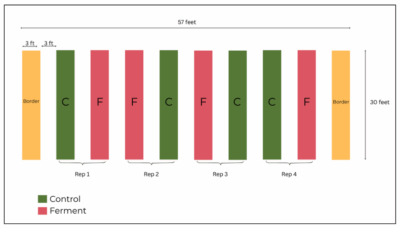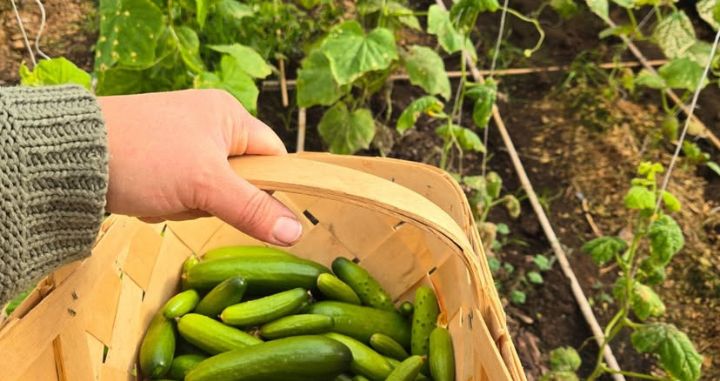
Mary (on right) with OFRF’s Research & Education Program Director, Thelma Velez (left)
By Mary Hathaway, OFRF Research & Education Program Manager
Organic farmers are curious. Working with nature to grow an abundance of food provides countless opportunities to learn and continue to improve farm production systems. OFRF has been listening to farmers since our inception, and the constant hum of curiosity, experimentation, and innovation has never diminished. In fact, as we have worked with more and more farmer and researcher teams, we’ve heard farmers express increasing interest in exploring questions and testing out what makes sense for their operations.
The launch of our Farmer-Led Trial program
Urged on by farmers’ questions, and with encouragement from the wonderful work of Practical Farmers of Iowa (PFI) and Ecological Farmers Association of Ontario (EFAO), OFRF took the leap to launch our Farmer-Led Trials (FLT) Program in 2024. This program supports organic farmers across the US who want to use the scientific method to trial ideas—in the hopes of learning the research process and what works for them and their farm system.
It has now been two years of working with farmers on their trials, and we are about to open applications for our third season. We started with our guidebook, “Farmers Guide to Conducting On-Farm Research,” which provides practical information, including examples from farmers and ranchers conducting on-farm research, links to additional resources, and worksheet templates for designing a sound research trial. It is available for free as a reference for any farmer or rancher wanting to conduct their own on-farm trials. Our goal is to support farmers in conducting trials in a way that generates reliable data and actionable results. We consider this free resource required reading for farmers who participate in the FLT Program, a 101, if you will. But like so many of my tactile friends, I learn from doing. And there is a lot of doing in farm trials!
Developing an on-farm trial

Trial plot map we developed with Women Trifecta Farm
Every on-farm trial begins with the farmer’s ideas—what have they been observing on their farm? What is it that they hope to achieve? We talk through their ideas, their production system, and their goals. From there, we walk through the seven core steps of setting up an on-farm trial, as outlined in the Farmers Guide. Together, we hone in on an appropriate research question, develop the trial plan, and come up with a strategy for collecting the necessary data. OFRF continues to provide support throughout the season, meeting with participants via phone two or three times after the plan is laid out, and helping to evaluate results and compile a final report at the end of the trial. As many of the farmers discover by the end of the trial, the year is just the beginning of a journey of testing out ideas. Once they get a behind-the-scenes peek and grasp how researchers might trial an idea and what that looks like for a farm, they see endless opportunities for continued investigation.
Managing contingencies with on-farm research
Life happens, and as farmers know all too well, weather really happens. In developing an on-farm trial, as with farming in general, there is a plan, and then there is what ends up happening. Together, OFRF and the farmers create the plan, and we hope the timelines work and pieces all fall into place. But inevitably it will be a wetter or drier year than expected, or livestock will get out and eat part of the trial plot, or some other unexpected thing will occur. Farmers get used to this, and just as with all other things, they keep moving, pivoting, and adapting to new situations. It can be challenging to stick with a trial. What seemed fun and exciting at the beginning of the season can become much more difficult to keep up with midway through the season, with dozens of other things vying for a farmer’s attention. In the spring, we love to plan and plot and scheme. Mid-season, when daylight lengthens with our workload, it is an extra piece in the day’s puzzle to make sure the data is collected and recorded, the marked out plots stay marked despite weeds or wind. Dedication at this point is what makes a trial successful. There can be no results without accurate data.
Analyzing data and learning together

Soil solarization in a high tunnel at Salad Days Farm
After months of growing, tending, and collecting information, eventually the time comes in the season when all the data is in. The yields have been weighed, or soil moisture has been measured, or compaction has been calculated. Generally, this is when things have slowed down for the season and farmers start to have a little more breathing room to reflect on results. I am not a statistical expert, but I am lucky to be paired with one. My colleague, Heather, works with the numbers, helping boil down the data into understandable results. We meet again with the participating farmers to talk through what the numbers are saying, and what that means for the farm. Many times, the results are surprising. For example, a farmer tested soil solarization, and we saw microbial biomass bounce back quicker than expected, and the fungal-to-bacterial ratio turned up higher under solarization than in bare soil, which was not what we had hypothesized. Whether surprising or affirming of what we suspected, the trial results are always informative. Time and again, what we have seen is learning—farmers learning something new about their farm, seeing data that confirms something they’d always suspected but weren’t sure was true, or understanding how to apply the scientific method to their operation in approachable ways.
While all of the farmers we’ve worked with have shared with us how much they learned throughout the on-farm trial process, I know that I am learning from them as much as they are from me. Each farmer teaches me so much. There is no limit to the interesting questions and thoughtful considerations that arise about what is happening on organic farms across the country, from the community level down to the microscopic. I only wish that I was able to visit each farm in person to connect more deeply with the farmer, their operation, and their research questions.
The observations each farmer comes to as they complete their trials can often be one of the biggest outcomes, even beyond the actual trial results. There is something to setting a frame around an object, such as setting aside a certain plot for a trial, or committing to walking an area of a field more often to take data points. There is much to be gained from letting our gaze fall with more attention. As Tim Colby, FLT participant and farmer at Colby Farms, put it, “We learned a lot by doing this trial. This land is still pretty new to me. So, the trial put me out walking the rows a lot more often and becoming more familiar with the soil and seeing how it’s changed. So, that is a tangible takeaway.”
Working with the farmers on these trials, I am also reminded how human we all are—how hard it is to narrow the questions down to test just one thing. The temptation to do so much at once seems universal. Almost every farmer we’ve worked with initially wants to create an ambitious, all-encompassing statement. My work with OFRF is to help ground us in science, and bring the scope of the trial down to an achievable level—a level where we can make a small, but accurate statement. But each statement is like a brick, adding one piece at a time to build the foundation of our understanding.
Looking ahead

Tim Colby uses a penetrometer to measure soil compaction
As preparations begin for the third year of OFRF’s Farmer-Led Trials program, I find myself humbled by the research questions and the outcomes. The generous and authentic work each farmer is doing to care for their land and feed their regions, while not harming the environment, is admirable. And the common interest among agriculturalists to better understand how things work—on a macro and micro-system scale—is inspiring.
I have worked as a farmer, with farmers, and for farmers. It is the thread that has tied my adult career together. I am so grateful that in this role, I get to be a small part of a journey for farmers around the country participating in OFRF’s FLT Program. As the ripple of this program grows larger with each year, we hope to see farmers we work with go on to build resilient systems, take on more robust trials such as with a SARE grant, or work with a researcher from their state or region to help build the body of knowledge we need to push organic farming systems into the forefront of production in the US. Like all the farmers embarking on these trials with us, I know that this is just the beginning, and there are so many more great questions out there to test.
Learn more
If you’d like to read more about the farmers who’ve participated in the FLT program so far, and what their trials have entailed, we’ve gathered a collection of the stories and final reports from past FLT Program participants here.
If you’re interested in participating in our next FLT cohort, applications are open Oct 15th-Dec 3rd, 2025, for the 2026 growing season. You can learn more about the program on our FLT page, or join our upcoming FLT Forum on Tuesday, October 21st, 2025, to hear from three former FLT farmer-researchers and gain an overview of the on-farm trial process.



